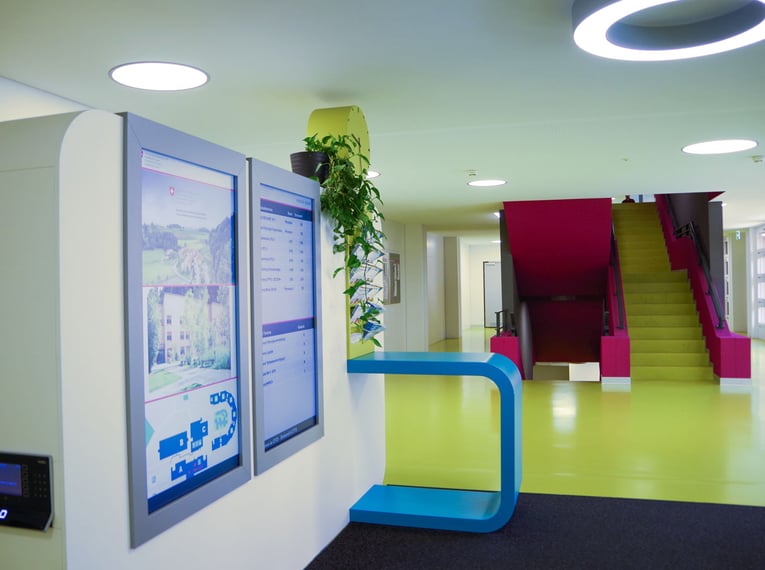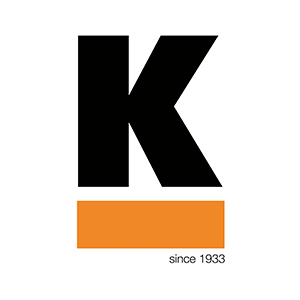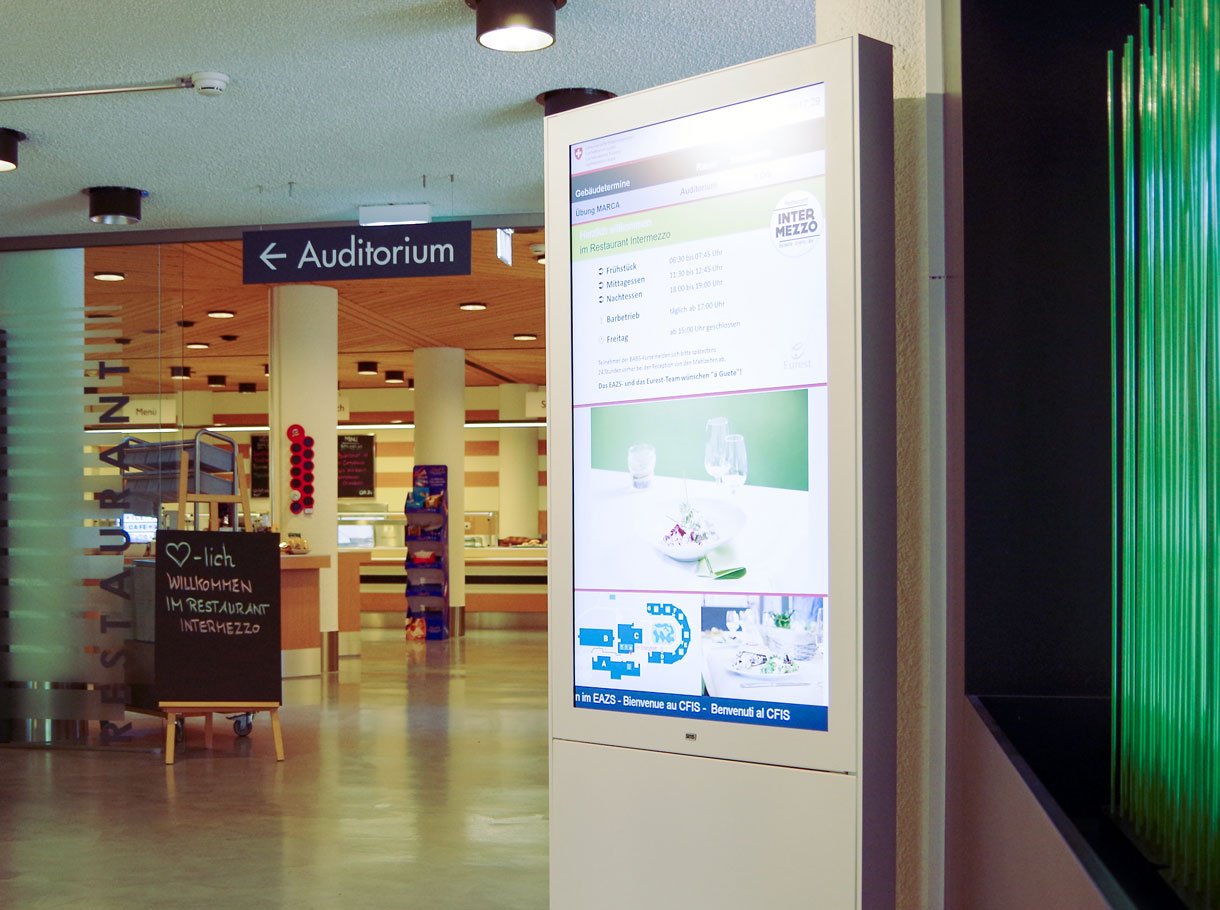
Interview with Sabrina Fuhrer, Head of Course Management. Implementation of a complete digital signage solution at the Federal Training Center in Schwarzenburg EAZS.
Simon Wegmüller, Swiss IT Magazine No.11 | November 2019
The Federal Training Center in Schwarzenburg EAZS, which consists of two school buildings, the central building with catering area and auditorium, as well as five modular accommodation buildings, is used for civil protection courses and public conferences and seminars, among other things. Instructors from the Federal Office for Civil Protection FOCP also run courses at the center, particularly for teaching staff, command bodies and civil protection cadres and specialists. The training center offers around 33 classrooms, three large plenary halls and 125 accommodation rooms with a total of 175 beds. The available premises are also rented out to other federal agencies, customers from the entire civil protection sector and interested parties from the private sector.
"Clear objectives are extremely important. What do I want, what do we actually need?"
Sabrina Fuhrer, Head of Course Management EASZ Schwarzenburg
Digital signage specialist Kilchenmann, based in the canton of Bern, was commissioned to equip the facility with a modern, complete digital signage solution. The customer's most important requirement was the ability to book rooms simultaneously while maintaining high security requirements. According to Sabrina Fuhrer, Head of Course Management at EAZS Schwarzenburg, this was made possible in particular thanks to the cloud-based solution from Easescreen. Today, there are three steles and an additional three screens at the main entrance, which are used as a guidance system through the buildings. The corresponding layout was tailored to the customer and implemented by Kilchenmann, continues Fuhrer.
Objectives and requirements
The overall infrastructure at the EAZS training center has not changed too much as a result of the collaboration with Kilchenmann, explains Fuhrer. However, the goal of finding a newer and user-friendly solution to better guide customers in the center to the relevant seminar rooms was achieved. "The existing system was getting on in years and needed to be replaced," Sabrina Fuhrer sums up. The decision to do this via a digital signage system was therefore made quickly. "As our center is divided into several buildings that are not connected to each other, a targeted signage system is absolutely essential," explains Fuhrer. "We wanted better visibility for the customer and easier handling for us." The main requirement was therefore clear visibility for the customer as well as clear, easy-to-understand handling for the training center as operator and for the users.
How the system should look and work was also clear from the outset: "The system had to work via online access, as no software could be installed," explains Fuhrer, adding: "It had to offer various presentation options. On the one hand, we wanted to guide customers, and on the other, we wanted to be able to show images, videos or presentations on the displays. We wanted to be able to adapt these flexibly and tailored to our needs."
Schwarzenburg is also happy with the current status, as the original idea could be turned into reality, even if minor adjustments were necessary. "Our ideas were met in full. We expected some adjustments in advance, but were then surprised that all our requirements could be implemented," says a satisfied Fuhrer
The search for the right partner
The decision for and search for the right implementation partner was crucial for the successful implementation of the project: "We first looked for existing solutions at federal level, but this didn't provide us with any viable solutions," reveals Fuhrer. "As we had already worked with Kilchenmann in other cases, we approached them directly with our request. The support offered played an important role here, and Kilchenmann's implementation partner also had to comply with the safety regulations. In addition, Kilchenmann already had experience in working with other federal agencies and also with the EASZ itself - so the right partner was quickly found."
The coordination with Kilchenmann went more or less smoothly, according to Sabrina Fuhrer: "There were one or two technical challenges, such as the server, but we managed to overcome these hurdles within a reasonable period of time." Kilchenmann was also able to present the EAZS with a solution that was tailored to the training center and within budget.
Implementation phase
Once the partner had been selected, the implementation of the project began. And since the team at EAZS was ultimately to use and manage the solution itself, it was important, according to Fuhrer, to define clear requirements and also to take the lead in the implementation. During the evaluation phase, for example, there was already a Kilchenmann employee on hand to support the EAZS.
"During the implementation phase, we then had a new contact person who already knew the tool well and supported us from A to Z," adds Fuhrer. "From the site visit to discussing the locations for the displays to the layout of the individual screens, we had to deal with this one person."
The project was launched in September 2018. "Effective collaboration with Kilchenmann then began in November. The project was then implemented during our summer vacations and the actual go-live was on 5 August 2019," says Fuhrer, summarizing the timeline from start to completion. With regard to the costs, however, the Head of Course Management only reveals that they were well below the WTO threshold.
Tackle problems early
However, as with every project, there were also difficulties and hurdles to overcome. "However, we had allowed enough time, as we knew from previous projects that the legal procurement requirements took time," says Fuhrer and admits: "There was also a change in the project team in the initial phase, which set us back quite a bit."
This change could clearly have been avoided, says Fuhrer: "If there had been more transparent communication among the project team members." The second major problem that arose was a technical one. This was also caused by a lack of communication. "An extended round of the project in good time would have helped us to recognize this hurdle earlier. In the end, we were able to implement the project on time thanks to the flexibility and commitment of everyone involved," says Fuhrer and advises: "My tip is open communication and a core project team that can be expanded by specialists if necessary."
Flexibility and fast response times
The final product of the project now consists of an outdoor display and five displays in the various buildings. "We present the current events at the center and the corresponding name of the seminar room on each of the screens," explains Fuhrer. "There are changing news tickers as well as images, videos and presentations. The room management itself runs via SAP." The information is also entered manually on a weekly basis or as required.
The system offers the training center a flexible way to react to everyday events, Fuhrer continues. "Customers can make requests for their seminar at short notice and the system's response time is fast. It is much more user-friendly than its predecessor and was already better accepted by my team as soon as it was introduced."
Fuhrer advises other companies that find themselves in similar situations to the EAZS and are considering implementing a digital signage project: "It's best to walk through the place with the eyes of a customer. In our case, I sent new trainees through the center to find their way around. They were able to give me some pointers with 'fresh' eyes." Clear objectives are also extremely important. "What do I want, what do we actually need? What has been positive so far, where do we need to optimize? I found it helpful to gather my ideas first and only then check the technical possibilities. In this way, you avoid premature censorship, which may not have been necessary at all," concludes Fuhrer.



